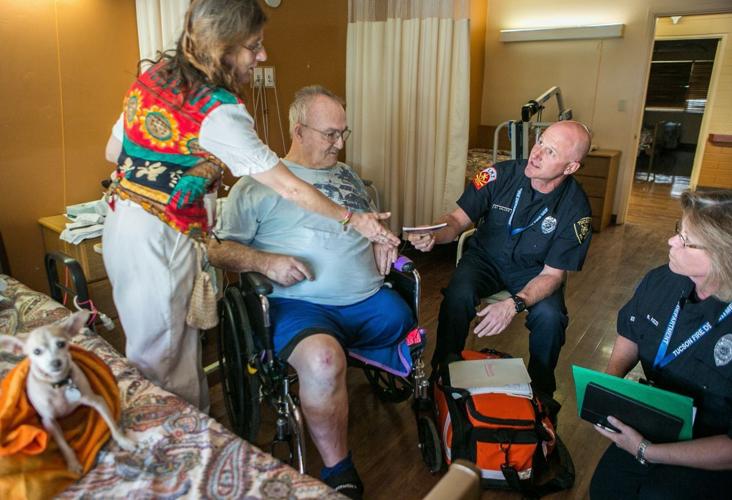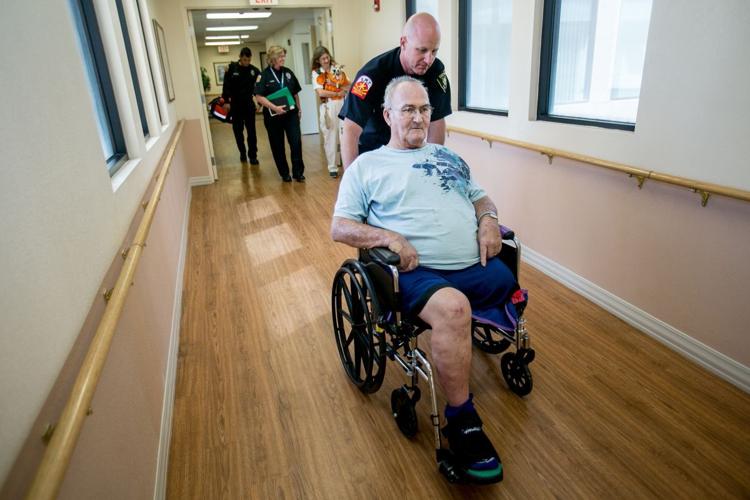Richard Smith lost his left leg to diabetes a year ago and is starting to feel loss of sensation in his other leg.
At age 72, the retired maintenance worker kept ending up on the floor in his apartment. The 6-foot-1-inch, 230-pound man was too big to lift for his wife, who stands at 5 feet 6 inches tall and weighs 120 pounds.
So Geri Smith, 53, would pick up the phone and repeatedly call 911 for help to get her husband back up on his scooter, recliner or bed.
Now, Smith is safe and living at Villa Maria Care Center. His physical therapy and long-term care at the center was navigated for the couple with the help of Brad Chilcote, a Tucson Fire Department firefighter who is a member of Tucson Collaborative Community Care, or TC3.
The department’s pilot program began in November and connects at-risk individuals with social services and health-care services.
Fire Capt. Mike Bishop manages the program, and his crew consists of firefighter and emergency medical technician Chilcote and paramedic Sue Rizzi, who both joined Bishop in February.
Bishop, a nearly 20-year veteran of the Fire Department, worked the program alone traveling for three months in a red pickup truck going to homes on nonemergency visits with people who were referred to the program by fire crews.
The crews recognized further services were needed for patients once they responded to their homes after receiving 911 calls. The firefighters then put the people into a referral system, Human Services and Referral Program, that was set up in 2008.
Bishop and his crew do follow-ups and make sure the clients’ needs are met by walking alongside them, if necessary, to get services. This is a component the earlier referral program lacked.
Bishop said he found people, who were lost on how to receive social services and health and behavioral care.
“They were using 911 for their general health-care needs because they did not know how to access the system for medical care, or had money to pay for costs or transportation to get to where they needed to go,” explained Bishop.
Many of the 911 callers had personal emergencies in their living situations that were not true medical emergencies, he said.
The TC3 team, which rides in a Fire Department pickup or sedan, gets people’s needs met so they then no longer need to call 911 for nonemergencies, which automatically sends an engine crew and paramedics to a scene.
Bishop and his crew connect with people who need to go to doctor visits, behavioral health appointments and to get their medications. They also can make sure the homeless get services through a network of resources.
When he worked alone, Bishop handled 30 cases, and with Chilcote and Rizzi, the team is now up to 70 cases total since November. They have completed 50 cases and are working to complete 20 more, Bishop said.
The TC3 program is paid for out of the Fire Department’s general fund and is set through August 2017.
The team will collect data on the cases and the cost-saving measures to the department, hospitals and insurance companies in hopes that the TC3 crews will grow and be incorporated into the Fire Department’s dispatch system.
“We are working to be aggressive in preventing medical emergencies through this mobile integrated program,” said Fire Chief Jim Critchley. “This is a community effort, and I am excited about the work everybody is doing.”






